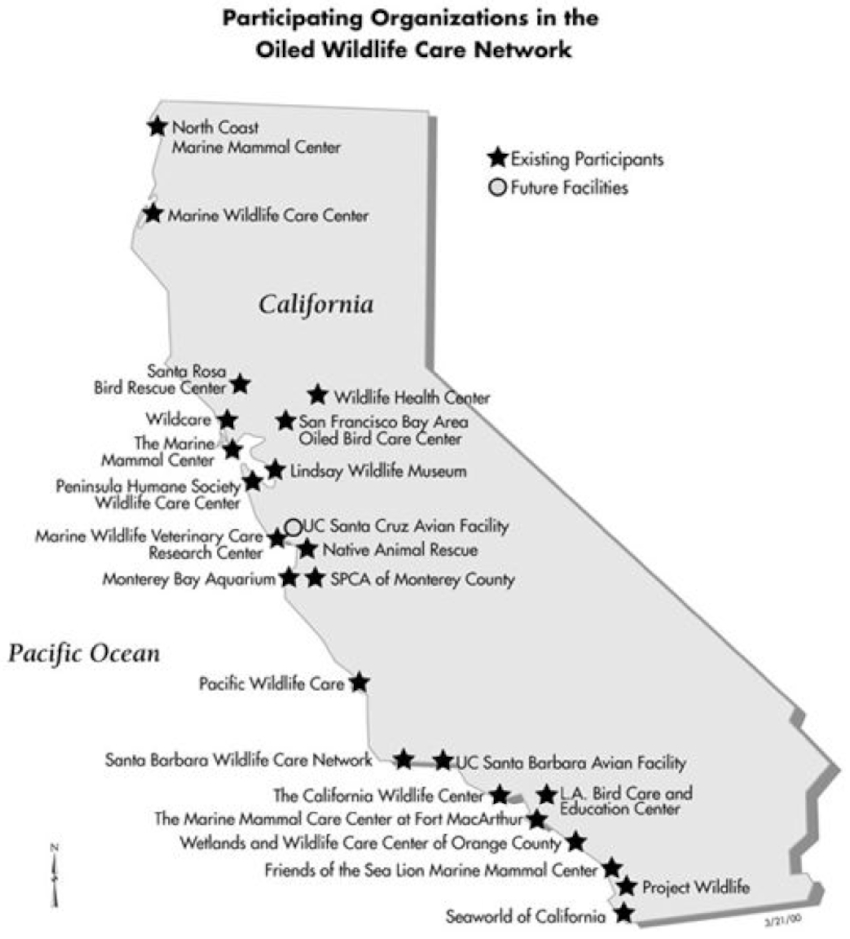Abstract
The Oiled Wildlife Care Network (OWCN) was created by the Lempert-Keene-Seastrand Oil Spill Prevention and Response Act (1990) which required the state of California to establish rescue and rehabilitation stations for sea birds, sea otters, and other marine mammals. The OWCN is sponsored by the California Department of Fish and Game’s Office of Spill Prevention and Response and funded through interest earned on an oil spill response trust fund to which the oil industry has contributed. The OWCN strives to ensure that wildlife exposed to petroleum products in the environment receive the best achievable treatment by providing access to trained personnel and permanent wildlife rehabilitation facilities maintained in a constant state of readiness. This oil spill response system includes a coordinated effort by federal, state, and local governments; the party responsible for the spill of the oil; and pre-identified non-governmental organizations, such as International Bird Rescue Research Center (IBRRC), specializing in all aspects of oil spill response.
The OWCN consists of 24 organizations with permanent facilities for marine birds and mammals in six regions of California. All of our facilities are maintained in a constant state of readiness, and wildlife care providers are available 24 hours/day, 365 days/year. Additionally, the seven newly constructed facilities have been designed for multiple non-oil spill uses. The marine mammal facilities participating in the OWCN are all pre-existing members of the National Marine Fisheries Service’s Marine Mammal Stranding Network.
In an attempt to identify the most important sites to locate new facilities, the state of California assessed the potential impacts and caseloads arising from oil spills by examining past history of oil spills, wildlife population and migration information, data on sensitive species, and analysis of shipping traffic. High priority locations were then targeted for development, considering the availability of trained volunteers and wildlife rehabilitation staff. The California plan included multiple regional facilities because the estimated caseloads from a catastrophic oil spill exceeded the capacity of any one facility that could be conceived and because preliminary evidence indicated that wildlife survival is positively influenced by immediate response capabilities and decreased transportation times to permanent rehabilitation facilities.
Facility size and design is generally determined by the anticipated wildlife caseloads and the alternative uses for the facility during times other than oil spills. In order to optimize the utility of facilities in California, minimize the cost of operating, and maintaining facilities constructed for oil spill response, we have chosen to partner with wildlife rehabilitation organizations and academic and educational institutions in the development of our oiled wildlife care facilities. The partner organizations benefit from the newly constructed and appropriately designed facilities for their non-oil spill uses, and the OWCN benefits from the constant maintenance of our facilities at reduced cost to the program. Optimally, those organizations which occupy the facilities during non-oil spill times are also those trained professionals and volunteers who will be available during oil spill response. With this type of partnership achieved, the facility occupants will not be displaced by the oil spill response because their program will be fully integrated into the effort.
As an example, new facilities under development for oiled wildlife response in the San Francisco Bay and Los Angeles regions will be staffed and managed by IBRRC. This arrangement provides space for non-oil spill related rehabilitation activities, which can be valuable in developing housing, nutritional, and medical protocols for species at risk during oil spills. In addition, educational programs for local school children which will be housed in these facilities increase public awareness of environmental issues and encourage community involvement during periods when the facilities are used for oil spill response. Other partners’ alternate uses focus on university-level teaching, administration, and research space, such as Humboldt State University and the University of California at Santa Barbara and Santa Cruz. An OWCN facility currently under construction in partnership with SeaWorld in San Diego will provide off-exhibit space for native protected species rehabilitation and quarantine facilities for birds prior to entering the SeaWorld collection.
Facilities designed for oil spill response should meet minimal space requirements and incorporate all required aspects of wildlife treatment and rehabilitation activities. Exterior space is also required for outdoor enclosures, seabird pools, and staging of response equipment. The minimal elements which must be incorporated into a functional oiled wildlife response facility include: intake/physical exam/evidence processing area, veterinary hospital with isolation capabilities, indoor wildlife housing/caging, food storage and preparation facilities, washing and rinsing areas, indoor drying pens, volunteer training/eating area with restrooms, administrative offices with multiple phone/fax lines and conference space, storage, outdoor pool and pen areas, pathology facilities, and access to a large parking area. The majority of these spaces are designed to serve other purposes during non-spill times.
Storage of oil spill response equipment and the feasibility of rapidly converting facilities from non-oil spill uses should be carefully considered in design. Many lessons have been learned in the construction of the OWCN facilities, including the use of special construction materials for sanitation and long life in coastal environments, the enormous fresh water demands for post-oil spill rehabilitation, the ventilation requirements of differently used spaces to prevent husbandry related diseases, and the land requirements for construction sites to accommodate expandable outdoor enclosures and overflow facilities when caseloads are exceeded.
Figure 1
